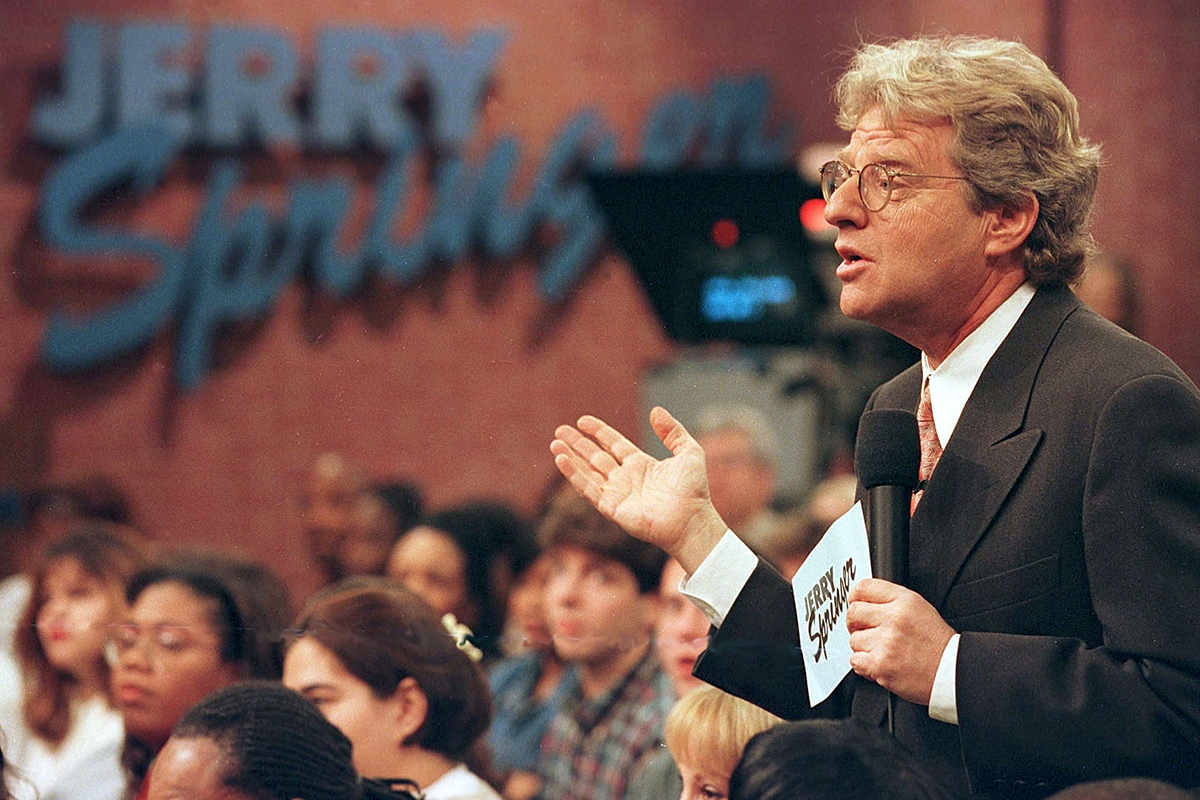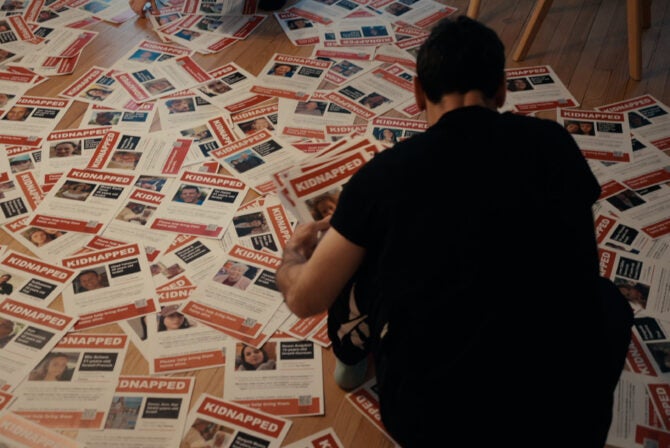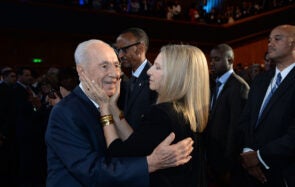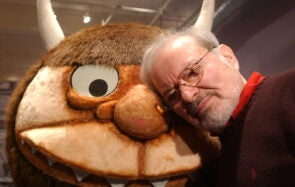I was excited to discover that Netflix was making a documentary about “The Jerry Springer Show,” the controversial talk show hosted by the late Jewish broadcaster who died from pancreatic cancer in 2023. Knowing Springer was the son of German refugees, I had long waited for something to explore both the story of the fascinating man behind the iconic show, and the show itself, which broke the mold of what TV could be and changed American culture forever.
And yet, the two-part series, “Jerry Springer: Fights, Camera, Action,” which is currently topping the streaming charts, left me wanting. While it certainly gives you a peek behind the scenes of “The Jerry Springer Show,” it’s ultimately salacious and moralizing, and left me feeling gross for merely consuming it, much in the same way I did when watching “The Jerry Springer Show” when it aired back in the ’90s.
One of the most fascinating documentaries about Springer actually aired on the radio more than 20 years ago. In a 2004 “This American Life” episode “Leaving the Fold,” Jewish radio producer Alex Blumberg, who grew up in Cincinnati where Springer was mayor between 1977 and 1978, traces Springer’s road from one of the most promising political voices in the country to a man remembered for hosting a brawl-filled show about incest and infidelity.
As the episode details, Springer was born in Britain in a London tube station in the midst of a German bombing. His family managed to escape in the nick of time, just months before the United States closed its borders to Jews escaping Nazi horrors — 27 of Springer’s relatives were killed by the Nazis. He made it to America when he was 5, where his family settled in Queens, New York. He studied law at Northwestern University and became the mayor of Cincinnati, winning his election despite an embarrassing prostitution scandal. After that, he went on to become a successful newscaster, the most popular one in his city, and a winner of 10 local Emmys, ending his broadcasts with that “take care of yourself and each other” tagline. And then, after that vaunted career, he became and will always be known for being the king of TV sleaze, creating “The Jerry Springer Show” that he never really managed to extricate himself from to revive the political career he always still dreamed of.
The wonderful thing about the way Blumberg tells that story, which I really recommend listening to if you haven’t yet, is that he comes to the tale of Springer with questions rather than determinations (something that feels so Jewish to me, always). He leaves it to the listeners to decide what to think of the man who, by all accounts, was a progressive idealist who deeply cared for people — especially the type of people that were guests on his show: people with less financial means, struggling, downtrodden, forgotten.
“Any job I’ve ever had, it’s been the same constituency,” Springer tells Blumberg in the episode. “It’s been middle and low-income people that need a voice, that need help, that need whatever. So, even in my entertainment, that’s my base. In politics, it certainly was my base. When I practiced law, it was my base. This is who I am.”
Blumberg, through the voices of Springer’s political allies and Springer himself, paints a complex, deeply human picture, and gives us the freedom to do with it what we will.
That is exactly the opposite of what director Luke Sewell does in the two-part Netflix documentary. He comes with a clear thesis: Jerry Springer and his show ruined the culture — a confession that Springer himself once made on TV. “The Jerry Springer Show,” which aired between 1991 and 2018, “contributed absolutely nothing positive to society in any way, and in many ways was incredibly negative,” according to Sewell.
To me, “Fights, Camera, Action” feels almost like a church confessional — the producers behind the show confess to their biggest “sins,” recall the show’s darkest moments, (before his death, Springer did not agree to participate in the film) and Roger Feder, the only cultural critic featured, absolves us viewers of the sin of consuming it — by constantly telling us how terrible it was, how everyone involved in the show should’ve known better, how it’s the worst show that has ever existed. And now look at how terrible the landscape of reality TV is, the docu-series asks, all because of Jerry, or moreso, the show’s executive producer Richard Dominick, who once said he would kill someone on live TV if it was legal.
Yet the docu-series itself is guilty of the very sins it accuses Springer’s show of, by repackaging and re-airing some of the show’s most controversial moments, because, as another producer of the show, Tobias Yoshimura, vindictively states at the end of the doc, that’s what the audience watching this documentary want the most — the scandal. That includes the episode about a man who married his horse, the tragic murder of Nancy Campbell-Panitz at the hands of her abusive ex-husband weeks after they appeared on the show, and one of the most Jewish scandals: the 1997 “Klanfrontation!”, when members of the Ku Klux Klan took the stage for a confrontation with the leader of the controversial Jewish Defense League, Irv Rubin, that broke into a fistfight.
“I think that it obviously led to quite a dark place,” Sewell told the New York Times about “Klanfrontation!”
In the documentary, Feder claims that Springer didn’t understand what he was getting himself into, but that as the son of Holocaust survivors, “he understood the real danger of bigotry and hatred” and should’ve known better than to give the Klan the spotlight.
Yet Springer himself disagreed with that analysis. “In a free society, the media should reflect all elements of that society, not just the mainstream,” he once argued. In a 1995 episode, he even confronted Holocaust denier and white supremacist August Kries, who would go on to be convicted of sexual assault of a minor. It was one of the few moments when security had to break up a fight between Springer and a guest.
What happened behind the scenes of the most controversial talk show ever made, one that beat even the great Oprah Winfrey when it came to ratings, that featured violent lovers’ spats and stories about incest and bestiality, seems now completely obvious. Producers, most likely unbeknownst to Springer himself, manipulated the often vulnerable guests, rehearsing and instigating strong emotional reactions to elicit the most explosive onscreen performances, plying them with drinks and throwing them on stage. They threatened guests, often from lower socio-economic backgrounds who came from a region one producer called “the Springer triangle,” which spanned states like Ohio, Georgia and Tennessee, who were visiting the big city for the first time, with rescinding their tickets back home from Chicago if they walked off stage. And they never made clear what should’ve been obvious to anyone who had ever watched the show — that Springer was not there to help them solve their problems in any profound way. He was there as the ringleader of a ratings circus.
Jerry Springer did say he offered counseling to his guests, which producers do not touch on in the documentary, and that for the most part, he cared for their human dignity. In an interview with Larry King, he said that the reason he kept working on the show after being set financially was because he loved meeting the real people who came on as guests. And he also offered a compelling reason for why so many people willingly went on his “circus,” aside from a trip to the big city: It was a chance for them to feel seen — for their troubles and their lives to get center stage in front of the entire nation. Missing from the documentary is Springer himself, who should’ve been a bigger character even without his physical presence. Unlike Blumber’s radio show, it does not explore Springer’s past — as the son of Jewish immigrants who came from such an unstable background — was lured in some ways by the incredible wealth it offered, one that would ensure him with a sense of safety that his parents never had.
Springer thought of his show as “chewing gum,” not good for you, nor bad. Yet it made people who felt invisible visible, sometimes the most awful people in American society, but a lot of the times just everyday human beings who were going through a complicated time. The show, for example, was inadvertently groundbreaking in the way it featured queer people, even if the representation was often negative.
I have no doubt that Jerry Springer was a complicated man, and the more I learn about his life and the impact of “The Jerry Springer Show,” the more questions I have. Why did we watch this show? What is our culpability as viewers who tuned in every time we did? What happened to those downtrodden guests? Did it really make some of them, and some of the people watching them, feel seen in their realness and messiness?
Unfortunately, “Jerry Springer: Fights, Camera, Action” doesn’t seem interested in asking, or answering, any of those questions.








